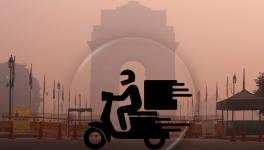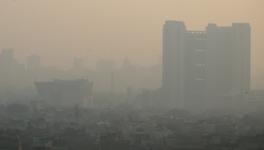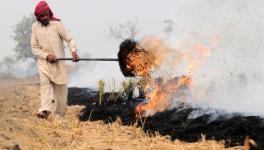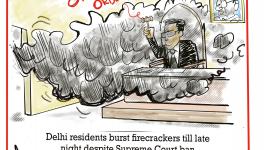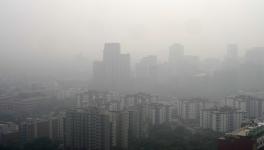Delhi Air Kills
According to the 2011 census, by 2030, the expected growth and demand in industrial, transportation, and domestic sectors will result in an increase in air pollution. This will spread from the big cities to secondary and tertiary cities. Newsclick spoke to Sarath Guttikunda, Director, UrbanEmissions.Info on this issue. According to him, air pollution is most often a symptom of inadequate urban planning. Lack of power supply leads to the use of diesel generator sets; lack of public transport leads to higher use of personal vehicles; no arrangement for walking and cycling leads to more motorised transport; lack of traffic management leads to congestion; lack of waste management system leads to waste burning; and lack of paved or covered roads leads to re-suspension of dust. The fact that air pollution is an externality from multiple sectors means that it needs to be addressed by multiple ministries that are willing to coordinate with one another. Technical solutions alone, like introducing CNG or changing standards for vehicles and industries, will not be sufficient to control air pollution in Indian cities. We need a change in the institutional setup in ways that will allow department and ministries to work together.
Rough Transcript:
Raghunandan: Hello and welcome to Newsclick. The pollution over Delhi and neighboring areas has gone down a little bit but so too has most of public interest and as a result policy makers are also asleep once again. To discuss this issue Newsclick is fortunate to have with us today Dr. Sarath Guttikunda one of the foremost experts on air pollution in the country. Welcome Sarath. Let me begin by asking you when the air pollution over Delhi was at its peak about a month ago, the media was full of all kinds of information particularly the print media. What I wanted to do today was first to cut through the chatter and ask you what are the main sources of pollution in Delhi around which policies can be framed to control it?
Sarath: Air pollution is a complex issue. There is no one straight forward answer. But when it comes to sources of air pollution that’s a very straight forward answer. We know where the pollution comes from. If we go by a baseline, your main sources are your vehicles both your passenger transport and trade transport. The dust suspension that happens because of these vehicles, construction activities, waste burning, so even though it’s officially banned we have a lot of waste burning that happens pretty much everywhere.
Raghu: So in response to the set of pollutants what would be the major measures you think are required to tackle these?
Sarath: So I think tackling pollution we can’t just fill up on one sector. All of these sectors need to be at the same level. So we can start with the sector we always talk of, transport sector. We are looking at a big chunk of passenger transport demand happening in the National Capital Region of Delhi. The country-wide if we have close to 10% of the registered vehicles are in the NCR region, puts a lot of pressure on that. So we need cleaner fuel for that, we do have the auto fuel policy which is supposed to come into effect by 2020 and pushing your Bharat is pure. There is no reason then why that cannot be pushed in advance basically 2017, 2018 so you have a big drop in the emissions. So within the transport sector you have to also worry about not just the fuel but also number of vehicles and usage. It is hard to put a cap on the number of vehicles that are on the road, we can’t tell people don’t buy cars, don’t bring out the car. But I think programs should be in place to cut the usage of these vehicles that is give incentives for them to not bring out their cars, not bring out their motor cycles, by aggressively promoting the use of public transport. You need at least 20,000 buses to have a good, clean, reliable, safe public transportion system where you actually have a significant change from buses and cars to public transportation. That’s on the transport side. We have emission standards in place for power plants and industries, for better regulations which are supposed to come into effect by December 2017. We should make sure that that happens and it doesn’t get delayed. The same thing with the garbage burning as well. One sector that actually belongs to the Muncipal Corporation, is completely under their control, they can’t point fingers at the Sanitor saying “they are not giving us permission”, “they are not allowing us to do this.”This is under city’s ordinance. They should have better management programs for waste and the same thing for the construction sector as well.
Raghu: Just coming back for a second to transport, most of the attention has been focused on particulate matter. But we also know there’s a fair amount of nitrogen oxides which are major pollutants particularly from diesel vehicles. What do you think can be done about that?
Sarath: Two things, either we get rid of or rather we reduce the usage of diesel in the city or we have a faster injection of cleaner diesel into the city. So that’s the major shift that has to happen.
Raghu: That’s right, as well as vehicular fitments etc to reduce the nox emissions.
Sarath: With the Bharat VI every vehicle will have to come with an SCR, selective catalytic converters and that will significantly drop your NO2 emissions. So while we are on the topic, in Delhi, in the past ozone was never an issue but now it is because your nox emissions are going up and your … emissions are also going up primarily from the transport sector and that is basically compounding itself with the weather and you have ozone. So if you look at ten years ago we never bothered about ozone but I think now we have to start worrying about that as well.
Raghu: What about construction sector? What kind of measures can be taken on that?
Sarath: It’s also a very tricky sector. The main thing is that the coverage of the construction sites have to be there. When the debris is being transported from the construction sites to the landfills the vehicles are supposed to be covered so that the debris doesn’t fly off and they’re also supposed to be wetted so that you don’t have some … going on. But we often see that on the roads especially at night trucks going at really high speeds not covered and debris keeps falling on the roads. So in the morning you have more vehicles on the road more dust resuspension that’s happening. It’s a bit of a vicious cycle.
Raghu: So let me ask apart from construction dust is there some estimation of ambient dust which as we know in Delhi tends to be rather high because of its proximity to the desert and to the dry regions around the city as well as a fair amount of dust emanating from within Delhi itself because of unpaved surfaces on the sides of roads?
Sarath: There is but it’s not a straightforward calculation for at least the dust which is on the roads we know how many vehicles are moving, usage and we can account for various suspension factors and say okay that this much dust is coming off. For the dust events, dust that is coming from the west, this is something which is linked to the meteorological parameters and it keeps fluctuating. In months like April and May, we’ve seen at least this year a really high number of dust events coming and some days it was almost close to forty-fifty per cent of the dust coming from the west. So even today, winds have actually picked up from the West which is why we have much less pollution in the last couple of days but it also is bringing a lot of dust from the West. And in models that we are running, at least today we are assuming, we are accounting for 15-20% of the PM 2.5 of the dust actually coming from outside the region.
Raghu: But with all the variations apart, one can safely say that a fair amount of these particles come over Delhi. This is fairly clear even from satellite maps…
Sarath: True, compared to two years ago the kind of satellite dish we have access to can really tell us how much area is under fire, where is it under fire and when is it under fire. And we are actually able to use that information, we know the land use of that area: agricultural land, forest land or urban land and where the fires are being detected and we can use that information to assess not only the emission intensity of those fires; combine that with the meteorology and we know that where it will move and how far and we are able to detect that. We do have a good amount of data feeds coming in and we are able to assess it, which also means that we can actually see the impact of these fires within twelve hours of detection and we can actually take measures in advance knowing what’s been happening for the last ten years.
Raghu: The Minister for Environment, the Union Minister made a statement in Parliament just a few days ago in response to a question about this and it occurred to me that this was a slightly disingenuous answer when he seemed to suggest that there is no very definitive data that shows that agri-residue burning in Punjab or Haryana impacts on Delhi.
Sarath: Contrary to that we have enough information to say (Raghu: I would have thought so) to ascertain; we are still modeling, we are not measuring; I think we have enough information from the meteorological department and from satellite feeds to come up not with an exact number but a range of how much pollution is coming from those fires.
Raghu: Exactly, we may argue whether it’s 15% or 25% but it’s a substantial amount and it’s going to happen every year unless something is done.
Sarath: Exactly and we have been seeing that for the last fifteen years and it’s more intense in the last few years; it’s going to happen.
Raghu: In your mind what kinds of institutional arrangements would be required to be able to control this, because clearly this is not a single agency job. It will require multiple agencies to co-ordinate and work together. So how is that likely to be, can you throw some light on this from experiences we know from other countries or regions of the world?
Sarath: Centrally speaking we do have the Central Pollution Control Board which actually has a mandate both to monitor the pollution levels and also has a mandate to propose scenarios or propose action plans that other departments can follow. I think when we are talking from managerial perspective Pollution Control Board is firstly rightly placed to take the lead, but it still has to co-ordinate with many different organizations. Having said that I think we need a group which actually has power to impose or more authoritatively to say: okay tomorrow’s pollution it doesn’t have to literally be tomorrow but next month or next year’s pollution is going to be so much, we know it that this is going to happen, so we need to target sector x, sector y and sector z and we need actions from these sectors. So that kind of planning has to happen from the beginning, there has to be a long view on how do we address this air pollution. That’s not going to happen with one group which primarily focuses only on monitoring. There has to be a central group, maybe it already exists, I don’t know, it can be formed probably with players from all these stakeholders coming together and put a plan forward.
Raghu: The reason I asked this is not only with reference to the pollution problem in Delhi, but I know the problem we are experiencing in Delhi is also being felt in other cities across the country. We need mechanisms to be able to deal with it.
Sarath: The low inversions that we saw last week in Delhi actually has been pushed and we are looking at some of the monitoring that has been coming from Kolkatta and Patna areas. Their pollution is right now, today three times worse than Delhi’s because everything is getting moved there and then getting suppressed there. So the phenomenon we are seeing in Delhi is not very unique, just that very high presence of media, more number of institutions, researchers, scientists I think they are all sitting in Delhi, studying in Delhi and studying Delhi a lot more. Hence the focus is more on Delhi. But the problem is definitely not restricted to Delhi. The common air pollution sources that we are discussing for Delhi also exists pretty much in all the cities; we need cleaner fuel for all the cities, better implementation of fuel emission standards for industries and power plants in all the cities. Your domestic heating and cooking problems exist in other places as well, more public transportation, that’s a key thing and waste burning ,let’s not forget that.
Raghu: Thank you very much Sarath.
DISCLAIMER: Please note that transcripts for Newsclick are typed from a recording of the program. Newsclick cannot guarantee their complete accuracy
Get the latest reports & analysis with people's perspective on Protests, movements & deep analytical videos, discussions of the current affairs in your Telegram app. Subscribe to NewsClick's Telegram channel & get Real-Time updates on stories, as they get published on our website.










